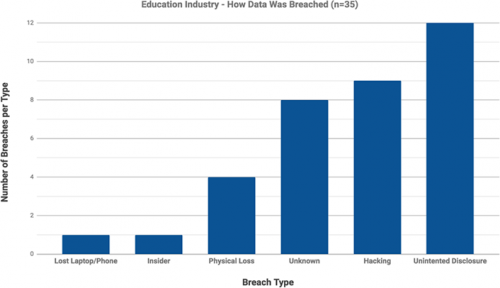Tech Tuesday: Cybersecurity is everyone’s responsibility
March 9, 2020
More than half of the breaches in the education sector were caused by activities directly attributable to human error, including lost devices, physical loss, and unintended disclosure (see figure 1). These breaches were arguably preventable through basic information security protection safeguards.
Figure 1. Types of security breaches among educational institutions

What can you do every day to protect data? There are very few, if any, verticals such as higher education that transmit, process, access and share such varying sensitive data elements. There is not a "one size fits all" blueprint for information security controls that all institutions can follow. Yet all campus members have a responsibility to know basic information security protections to safeguard data and prevent those data from being mishandled:
- Update your computing devices: Ensure updates to your operating system, web browser, and applications are being performed on all personal and institution-issued devices. If prompted to update your device, don't hesitate—do it immediately.
- Create really strong and unique passwords: Create unique passwords for all personal and work accounts.
- Enable two-factor authentication wherever it’s available: Whether for personal use or for your UA email, two-factor authentication can prevent unauthorized access even if your login credentials are stolen or lost.
- Protect your devices: Using biometrics or six-digit passcodes on smartphones and tablets is critical to keeping curious minds from accessing personal information, work email, or retail/banking applications. It also helps protect your device if you lose or misplace it.
- Understand where, how, and to whom you are sending data: Many breaches occur because of "oopsie moments" where we accidentally post sensitive information publicly, mishandle or send to the wrong party via publishing online, or send sensitive information in an email to the wrong person. Taking care to know how you are transmitting or posting data is critical.
Questions about how you can protect university and personal data? As always, your service desk is here to help!
Anchorage
Technical support center: 907-786-4646
Toll-free: 877-633-3888
uaa.techsupport@alaska.edu
Fairbanks
Phone: 907-450-8300
Toll-free: 800-478-8226
helpdesk@alaska.edu
Juneau
Phone: 907-796-6400
Toll-free: 877-465-6400
uas.helpdesk@alaska.edu


